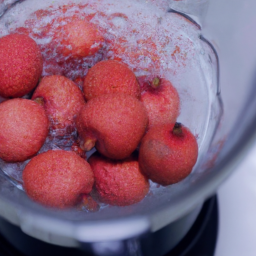Hey there! Do you enjoy tropical drinks? If you do, you’re in for a treat. In this tutorial, I will guide you on how to make delicious and refreshing coconut juice right from the comfort of your own home.
Not only is coconut juice a tasty beverage, but it’s also packed with incredible health benefits that will have you feeling great all day long. Coconuts are an amazing source of hydration, electrolytes, and nutrients, making them a perfect choice for a post-workout drink or a healthy way to start your day.
Plus, making coconut juice at home is surprisingly easy and cost-effective. With just a few simple steps, you can have a refreshing glass of coconut juice that’s bursting with flavor and nutrition. So, let’s get started!
Key Takeaways
- To make coconut juice, start by selecting ripe coconuts that are heavy for their size and have a distinct sound when tapped.
- Clean the coconuts thoroughly and remove the meat from the shell to access the coconut water.
- Enhance the flavor of the coconut juice by adding fruits, sweeteners, herbs, and spices, and boost the nutritional value by adding chia seeds and fresh lime juice.
- Properly store the coconut juice in airtight containers or plastic wraps to maintain its freshness and flavor. Freezing coconut water in ice cube trays can also extend its shelf life.
Benefits of Coconut Juice
Coconut juice is a refreshing and hydrating drink that’s packed with electrolytes and nutrients, making it a great choice for post-workout recovery or a hot summer day. As a hydration source, coconut juice is a natural alternative to sports drinks that are often loaded with sugar and artificial ingredients. It helps replace fluids and minerals lost through sweating, making it an ideal drink for those who lead an active lifestyle.
In addition to being a hydration source, coconut juice is also an electrolyte replacement. Electrolytes are essential minerals that regulate the body’s fluid balance, muscle contractions, and nerve function. Coconut juice contains potassium, sodium, and magnesium, which are all electrolytes that help maintain proper body function.
So, if you’re looking for a natural and healthy way to replenish your body after a workout or a long day in the sun, coconut juice is the way to go. And the first step in making delicious coconut juice is choosing the right coconuts.
Choosing the Right Coconuts
To get the perfect coconut for your refreshing drink, you’ll need to feel for a certain weight and listen for a specific sound when tapping it – can you hear it?
When selecting fresh coconuts, it’s important to choose ones that feel heavy for their size. This indicates that they are full of water and the meat inside is still fresh. A ripe coconut will also have a distinct sound when tapped. You should hear a deep, resonating thud. If it sounds hollow, then it may be overripe or dried out.
Identifying ripe coconuts is crucial in making delicious coconut juice. Look for coconuts with a brown, hairy exterior. If the exterior is green, then it’s not ripe yet. You can also tell if a coconut is ripe by shaking it to hear if there is water inside.
Once you have selected the perfect coconuts, it’s time to prepare them for juicing.
Preparing the Coconuts
Once you’ve got the right coconuts, it’s time to start getting them ready for some delicious, refreshing goodness.
The first step in preparing the coconuts is to clean them thoroughly. I usually start by washing them with warm water and a little bit of soap to remove any dirt or debris. After rinsing them off with clean water, I let them dry for a few hours before moving on to the next step.
Next, it’s time to remove the coconut meat from the shell. This can be done using a variety of tools, depending on your preference. Some people use a sharp knife to carefully cut away the meat, while others prefer to use a coconut scraper or grater to shred the meat off the shell.
Once the meat has been removed, it’s time to move on to enhancing the flavor of the coconut juice.
Enhancing the Flavor
So, after preparing the coconuts and extracting the juice, it’s time to take the flavor to the next level!
Personally, I love experimenting with different fruits to add a touch of freshness and sweetness. Additionally, adding sweeteners like honey or agave can balance out the natural tanginess of the coconut water. Lastly, incorporating herbs and spices like mint, ginger, or lemongrass can provide a unique and refreshing taste that will leave your taste buds wanting more.
Let’s dive into the world of flavor-enhancing and take your coconut juice to the next level!
Adding Fruits
Fruitfully flavor your coconut juice by blending in your favorite fruits. From sweet berries to creamy bananas, the possibilities are endless. You can even add a hint of tangy citrus to give your drink a zesty twist. Fruit combinations are perfect for adding a burst of flavor to your coconut juice, making it even more refreshing and satisfying.
To make it easier for you to experiment with different fruit combinations, here is a table of suggested fruits and serving ideas:
| Fruit | Serving Ideas | Flavor Profile |
|---|---|---|
| Strawberries | Sliced or pureed | Sweet, slightly tart |
| Blueberries | Whole or pureed | Tangy, slightly sweet |
| Raspberries | Sliced or pureed | Tart, slightly sweet |
| Bananas | Sliced or mashed | Creamy, sweet |
| Oranges | Sliced or juiced | Zesty, tangy |
With these options, you can customize your coconut juice to your liking. Adding fruits not only enhances the flavor but also increases the nutritional value. So go ahead and experiment with your own fruit combinations to create a delicious and healthy drink. Next, we’ll explore how to add sweeteners to your coconut juice to further enhance the taste.
Adding Sweeteners
To sweeten up your drink, you’ll want to add a touch of sweetness with your preferred sweetener. There are many options to choose from, including natural sweeteners and artificial sweeteners. Here are some examples of sweeteners you can use:
-
Honey – a natural sweetener that adds a rich, floral flavor to your coconut juice.
-
Stevia – a calorie-free sweetener that comes from a plant and has become a popular alternative to sugar.
-
Agave nectar – a natural sweetener that has a low glycemic index and can be used in small amounts to sweeten your coconut juice.
-
Sugar – a classic sweetener that adds a simple sweetness to your drink. However, it’s important to use it in moderation as it can be high in calories.
Adding a sweetener to your coconut juice can enhance the flavor and make it more enjoyable to drink. Once you’ve added your preferred sweetener, you can then move on to adding herbs and spices to give your drink an extra kick.
Adding Herbs and Spices
After experimenting with different sweeteners, I decided to take my coconut juice recipe to the next level by adding herbs and spices. Herbal infusions have been used for centuries to add flavor and a variety of health benefits to drinks.
I started by steeping a few sprigs of fresh mint in hot water, and then adding the resulting infusion to the coconut water. The mint added a refreshing burst of flavor and also helped to calm my stomach.
Next, I decided to try creating a spice blend to add a little kick to my coconut juice. I mixed together cinnamon, ginger, and a pinch of cayenne pepper, and added it to the coconut water. The cinnamon and ginger added warmth and depth, while the cayenne pepper gave the juice a subtle heat. It was a perfect balance of flavors that made me feel like I was sipping a tropical cocktail.
Now, let’s talk about how to improve the nutritional value of your coconut juice by adding some key ingredients.
Improving Nutritional Value
If you want to boost the nutritional value of your coconut juice, you should try adding some chia seeds or a splash of fresh lime juice. Chia seeds are packed with fiber, protein, and omega-3 fatty acids, making them an excellent addition to any meal planning.
Adding a tablespoon of chia seeds to your coconut juice can help you feel fuller for longer and can even help regulate your blood sugar levels. On the other hand, fresh lime juice is rich in vitamin C, which can boost your immune system and help your body absorb iron from plant-based foods.
Incorporating these simple additions to your coconut juice can provide some incredible nutritional benefits. Not only can you enjoy a refreshing and hydrating beverage, but you can also feel good about the nutrients you’re providing your body.
The next section will focus on how to properly store your coconut juice to ensure it stays fresh and delicious for as long as possible.
Storing Coconut Juice
Properly storing your freshly squeezed coconut juice is essential to maintaining its freshness and flavor. After extracting the juice from the coconut, strain it through a fine mesh strainer to remove any remaining pulp or debris.
Then, pour the juice into a clean, airtight container. It’s important to store coconut juice in the refrigerator at a temperature of 40°F or below to prevent spoilage.
When stored properly, coconut juice can last up to five days in the refrigerator. However, if you want to extend its shelf life, you can freeze the juice in ice cube trays or freezer-safe containers. Simply thaw the frozen juice in the refrigerator before using it in recipes.
Now that you know how to properly store coconut juice, let’s move on to how you can use it in recipes to add flavor and nutrition to your dishes.
Using Coconut Juice in Recipes
I absolutely love using coconut juice in my recipes! Whether it’s for a refreshing smoothie, a tropical cocktail, or for cooking savory dishes, coconut juice adds a deliciously sweet and nutty flavor.
In smoothies, it’s the perfect base for mixing with fruits and veggies. In cocktails, it adds a unique twist to classic drinks. And in cooking, it can be used to marinate meats or add flavor to rice and quinoa dishes.
Let’s dive into the different ways we can use coconut juice in our recipes!
Smoothies
One easy way to enjoy coconut juice is by blending it with your favorite fruits to make refreshing smoothies. Smoothie recipes using coconut juice can be easily found online, and they’re a great way to get a burst of nutrients and hydration in one drink.
Adding coconut juice to your smoothies can provide several nutritional benefits, including antioxidants, electrolytes, and vitamins. It can also help improve digestion and boost your energy levels.
Some popular coconut juice smoothie combinations include pineapple, mango, and banana, or strawberry, blueberry, and spinach. The possibilities are endless, and you can customize your smoothie to suit your taste and nutritional needs. Plus, coconut juice adds a subtle sweetness and tropical flavor to the drink, making it a delicious and healthy way to start your day.
As for cocktails, there are many ways to incorporate coconut juice into your favorite drinks, such as piña coladas or coconut margaritas.
Cocktails
Moving on from smoothies, let’s talk about cocktails! There are so many variations of cocktails that you can make using coconut juice. As someone who loves to experiment in the kitchen, I find it really fun to mix and match different ingredients to create unique and delicious drinks.
Here are some ideas for coconut juice cocktails that you can try at home:
-
Coconut Margarita – Mix coconut juice with tequila, lime juice, and agave syrup for a tropical twist on a classic margarita.
-
Pineapple Coconut Mojito – Muddle fresh mint with pineapple chunks, add coconut juice, rum, lime juice, and club soda for a refreshing summer drink.
-
Coconut Piña Colada – Blend coconut juice, pineapple juice, and rum with ice for a frozen treat that will transport you to a beach in the Caribbean.
-
Coconut Lime Daiquiri – Shake coconut juice, lime juice, white rum, and simple syrup with ice for a tangy and sweet drink that’s perfect for hot days.
If you’re not in the mood for alcohol, you can also make coconut juice mocktails by simply omitting the liquor and adding more juice or soda. These drinks are just as delicious and refreshing, and they’re perfect for kids and non-drinkers.
Now, let’s move on to the next section where we’ll talk about cooking with coconut juice.
Cooking
Get ready to experience the ultimate explosion of flavor in your dishes with the addition of coconut! This versatile ingredient can be used in a variety of cooking techniques, from sautéing to baking, and offers a range of flavor profiles that can enhance both sweet and savory dishes. Whether you’re making a creamy coconut curry or adding coconut flakes to your morning oatmeal, the possibilities are endless.
To help you incorporate coconut into your cooking, here’s a table outlining some popular coconut products and their uses:
| Coconut Product | Uses |
|---|---|
| Coconut Milk | Creamy base for curries, soups, and smoothies |
| Coconut Oil | Great for sautéing, baking, and as a dairy-free butter substitute |
| Shredded Coconut | Adds texture and flavor to baked goods, granolas, and salads |
| Coconut Flour | Gluten-free alternative to wheat flour in baking |
| Coconut Aminos | Soy-free alternative to soy sauce in marinades and dressings |
By experimenting with these coconut products and cooking techniques, you can unlock a whole new world of flavors and take your dishes to the next level. Now, let’s move on to the benefits of making coconut juice at home.
Benefits of Making Coconut Juice at Home
I love making my own coconut juice at home for several reasons. First and foremost, it’s cost-effective. Buying pre-made coconut juice from the store can be quite expensive, but making it at home is much more affordable.
Secondly, making coconut juice at home ensures its freshness. I know exactly what goes into it and can control how long it sits in the fridge.
Lastly, I can customize it to my liking by adding different fruits or sweeteners. Making your own coconut juice at home is not only easy and fun, but it also has many benefits.
Cost-Effective
Saving money on coconut juice can be easy by using reusable straws and buying coconuts in bulk. Instead of purchasing pre-made coconut water from the store, I prefer making it at home with affordable ingredients and a DIY approach.
Here are some tips on how to make coconut juice cost-effective:
- Buy coconuts in bulk: Purchasing coconuts in bulk is cheaper than buying them individually. This is especially useful if you plan on making coconut juice on a regular basis.
- Reusable straws: Using reusable straws instead of disposable ones not only saves money but is also more environmentally friendly.
- Use all parts of the coconut: Instead of throwing away the coconut meat after extracting the water, use it to make coconut milk or even coconut flour.
- Make large batches: Making a large batch of coconut juice at once can save time and money in the long run.
By following these tips, you can make delicious coconut juice at home without breaking the bank. Plus, making it yourself ensures that you know exactly what goes into your drink and can avoid any unnecessary additives.
Now, let’s move on to the next section to learn about the importance of freshness in making coconut juice.
Freshness
To ensure the best flavor in your drink, it’s important to consider the freshness of the ingredients used. For example, if you are using coconuts that have been sitting on a shelf for weeks, the taste of the resulting juice may be compromised. Preserving freshness is key to making delicious coconut juice. One way to do this is by storing the coconuts properly. Keep them away from direct sunlight and at room temperature to slow down the ripening process. Another method is to use airtight containers or plastic wraps to seal the coconut meat. This will help extend the shelf life and maintain the quality of the fruit.
To further extend the shelf life, you can also freeze the coconut water in ice cube trays. This way, you’ll always have fresh coconut juice on hand whenever you want it. However, it’s important to note that freezing can alter the taste and texture of the juice, so it’s best to consume it within a few weeks. By keeping these tips in mind, you can ensure that your coconut juice is bursting with flavor and freshness. And now, let’s move on to the next step of customization.
Customization
You can elevate your drink experience by tailoring it to your taste preferences. Adding different flavors to your coconut juice can make a huge difference in the way you enjoy it. One great customization idea is to make flavored ice cubes.
You can freeze some fresh fruits, such as berries, or even some herbs, like mint, with water to add a twist to your drink. When the ice cubes melt, they will infuse your coconut juice with a unique and refreshing taste.
Another way to customize your coconut juice is to experiment with different serving vessels. Instead of a regular glass, try using a coconut shell or a mason jar. Not only will this make your drink look more enticing, but it will also add a touch of personality to your beverage.
You can even garnish your drink with some fresh fruit slices or a sprig of mint to make it even more visually appealing. To ensure that your coconut juice is safe to consume, it’s important to take some necessary precautions.
Safety Precautions
Before you end up resembling a human piñata, it’s crucial to remember to wear protective gear such as gloves and goggles while cracking open a coconut. The tough outer shell of the coconut can be quite tricky to open, and without proper protection, you might end up with cuts and bruises on your hands and face.
Once you have your protective gear on, it’s time to move on to the next step. Hand hygiene and kitchen sanitation are also essential when making coconut juice. Before handling the coconut, make sure to wash your hands thoroughly with soap and water.
Also, ensure that your kitchen area is clean and free from any contaminants. Once you have opened the coconut and extracted its juice, make sure to store it in a clean container and refrigerate it immediately to prevent any spoilage.
By following these simple safety precautions, you can enjoy a refreshing glass of coconut juice without any worries.
Frequently Asked Questions
How long does it take to make coconut juice from start to finish?
It takes only a few minutes to make coconut juice, but the key to improving its taste is adding a pinch of salt and a squeeze of lime. Leftover coconut water should be stored in the refrigerator to prevent spoilage.
Can I use any type of coconut to make coconut juice?
Yes, you can use various types of coconuts to make coconut juice. Young coconuts are best for juice, but mature coconuts can also be used. Coconut juice variations include adding fruit or herbs. Different ways to use coconut juice in recipes include smoothies, cocktails, and marinades.
How many coconuts do I need to make a certain amount of coconut juice?
To make a certain amount of coconut juice, it depends on the size and freshness of the coconuts. Generally, one coconut yields about 1.5-2 cups of juice. Mixing different types of coconuts is possible.
Is it necessary to strain the coconut juice before drinking?
I always strain my coconut juice to remove any pulp, but there is a Straining Debate. Some say it’s more nutritious with the pulp, but straining makes it easier to drink. There are also Health Benefits, like hydrating and aiding digestion.
Can I freeze coconut juice for later use?
Yes, you can freeze coconut juice for later use. It’s best to store it in an airtight container and consume it within 6 months for optimal freshness. Freezing options provide convenience and extend the shelf life of coconut juice.
Conclusion
In conclusion, making coconut juice at home is a simple and rewarding process. It not only offers numerous health benefits, but it also allows you to control the ingredients and flavor. As someone who loves the taste of fresh coconut juice, I couldn’t resist trying it out for myself and was pleasantly surprised with the results.
Coincidentally, on the day I decided to make coconut juice, the weather was scorching hot and I was in desperate need of a refreshing drink. The cool and crisp taste of the coconut juice was exactly what I needed to quench my thirst and invigorate my body. I also loved that I was able to experiment with different flavors and add-ins, such as lime and mint, to create a personalized and unique drink.
Overall, making coconut juice at home is a fun and healthy activity that anyone can do. By following the steps outlined in this article, you can enjoy the benefits of this delicious drink while also impressing your friends and family with your culinary skills.
So go ahead and give it a try – you won’t regret it!
Ilana has been a vegan for over 10 years. She originally made the switch for health reasons, but soon found herself becoming more and more passionate about the ethical and environmental implications of a vegan lifestyle. Ilana is the author of The Graceful Kitchen, a blog all about veganism. She loves to cook up delicious and nutritious vegan meals, and share her recipes with others who are interested in leading a cruelty-free life. Ilana is also a strong advocate for using whole foods as the foundation of a healthy diet, and believes that going vegan is one of the best ways to achieve this.










